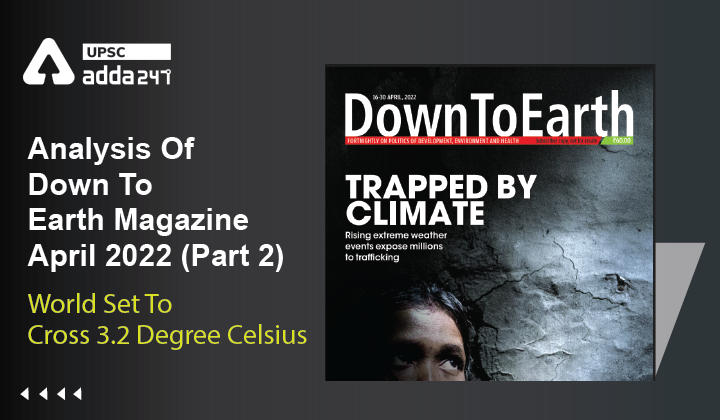Table of Contents
Analysis Of Down To Earth Magazine ”World Set To Cross 3.2 Degree Celsius”
Relevance
”GS 3: Environmental Pollution & Degradation, Conservation”
Context
- The third instalment of the Sixth Assessment Report, released by the Intergovernmental Panel on Climate Change (IPCC), on April 4, 2022 shows that the time is running out and the world, despite having worthy clean alternatives, is not doing enough.
- According to the report, if current policies implemented by the end of 2020 are not strengthened, the world is on track to warm by 3.2 Degree C by 2100.
Key Findings
- The report says that in 2019, global net anthropogenic greenhouse gas (GHG) emissions, at 59 gigatonnes of carbon dioxide equivalent were 54 per cent higher than that in 1990.
- This growth was driven by CO2 emissions from the burning of fossil fuels for energy and industries, as well as methane emissions.
How did Paris Agreement Pledges Fall Short?
- Upon adding up NDCs announced by countries till October 2021, IPCC finds that warming could hit 2.8 Degree C by 2100.
- CO2 emissions from existing and planned fossil fuel infrastructure—coal, oil and gas— contribute to this projected failure.
About IPCC
- The Intergovernmental Panel on Climate Change (IPCC) is the United Nations body for assessing the science related to climate change.
- The IPCC prepares comprehensive Assessment Reports about the state of scientific, technical and socio-economic knowledge on climate change, its impacts and future risks, and options for reducing the rate at which climate change is taking place.
- It also produces Special Reports on topics agreed to by its member governments, as well as Methodology Reports that provide guidelines for the preparation of greenhouse gas inventories.
What is C1 Pathway?
- In its best-case scenario, known as the C1 pathway, IPCC outlines what the world needs to do to limit temperatures to 1.5 Degree C with limited or no “overshoot” (this refers to global temperatures crossing the 1.5o C threshold temporarily, but then being brought back down using technologies that suck CO2 out of the atmosphere).
- To achieve the C1 pathway, global GHG emissions must fall by 43 per cent by 2030, compared to 2019 levels, amounting to 31 GtCO2 emissions in 2030.
- More importantly, the use of coal, oil and gas must decline by 95 per cent, 60 per cent, and 45 per cent respectively by 2050, compared to 2019.
What does the World need to do?
- The report states with high confidence that several mitigation options, such as solar energy, wind energy, urban green infrastructure, improved forest- and crop/grassland management, and reduced food waste and loss are technically viable, becoming cost-effective, and are supported by the public.
- Low-cost mitigation options, costing US $100 per ton CO2 or less, can halve global GHG emissions by 2030.
- In fact, the long-term benefits of limiting warming far outweigh the costs.
- Investing in decarbonisation would also have a minimal impact on the global Gross Domestic Product (GDP).
- Demand-side mitigation measures, such as adopting plant-based diets, or shifting to walking and cycling, can reduce global GHG emissions in end-use sectors by 40-70 per cent by 2050.
Key Challenges
- Most of the potential for demand-side mitigation currently lies in developed countries only.
- Finance flows for fossil fuels are still greater than those for climate adaptation and mitigation.
- Climate policies can encounter resistance from corporations and associations who “often lobby against measures they deem detrimental”.
Conclusion
Building out massive solar and wind facilities, electrifying transportation, protecting fragile eco-systems, and creating infrastructure that will push low-carbon personal choices are all possible today. Any delay will prove costly; every additional year of inaction depletes the carbon budget and pushes the planet closer to dangerous extremes.



 TSPSC Group 1 Question Paper 2024, Downl...
TSPSC Group 1 Question Paper 2024, Downl...
 TSPSC Group 1 Answer key 2024 Out, Downl...
TSPSC Group 1 Answer key 2024 Out, Downl...
 UPSC Prelims 2024 Question Paper, Downlo...
UPSC Prelims 2024 Question Paper, Downlo...
